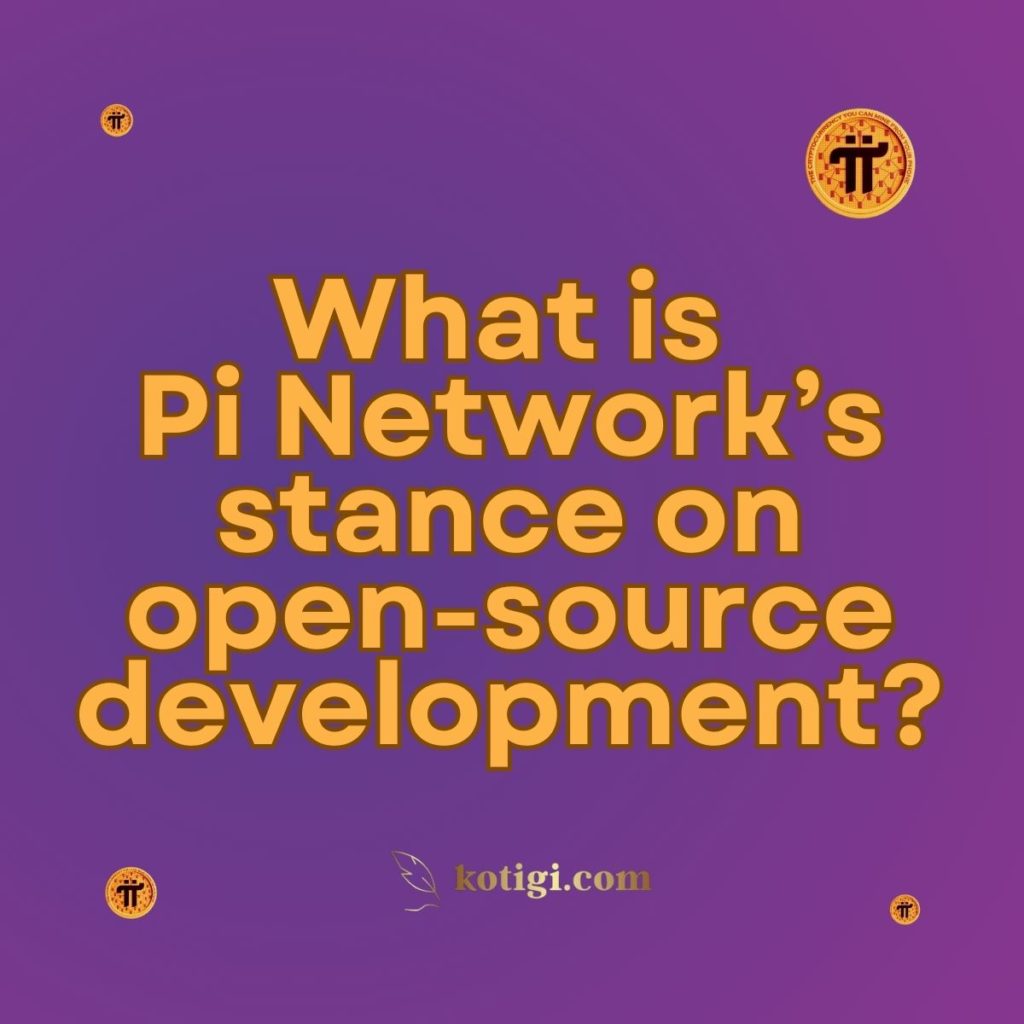
What is Pi Network’s stance on open-source development?
Pi Network embraces open-source development as a crucial component of its mission to build a decentralized and inclusive blockchain ecosystem. By encouraging collaboration from developers worldwide, Pi Network fosters innovation, transparency, and scalability. This post explores Pi Network’s stance on open-source development, its benefits, and how it aligns with the broader vision of creating a sustainable and accessible cryptocurrency platform.
Introduction
Open-source development has become a cornerstone of blockchain technology, promoting collaboration, transparency, and innovation. Pi Network, in its effort to create a decentralized ecosystem, adopts an open-source approach to development. This stance not only encourages developers to contribute to the platform’s growth but also enhances trust within the community by making the project’s code accessible and auditable. In this article, we will explore Pi Network’s commitment to open-source development, its advantages, and how this aligns with the project’s broader goals of decentralization and financial inclusion.
1. Pi Network’s Commitment to Open-Source Development
Pi Network’s commitment to open-source development reflects its desire to build a transparent and collaborative ecosystem. By opening its code to developers worldwide, Pi Network encourages a community-driven approach to building and improving the platform. This transparency fosters trust among users and developers alike, as they can inspect, contribute to, and verify the integrity of the platform’s underlying technology.
1.1 Transparency and Trust
Open-source development is synonymous with transparency, a key value for blockchain projects. By making its code publicly available, Pi Network invites scrutiny from developers and the broader community, ensuring that its technology remains secure and trustworthy. Transparency in development also aligns with Pi Network’s broader mission of creating a decentralized ecosystem, where no single entity has absolute control over the platform. This openness allows users to verify that the project adheres to its principles of fairness and inclusivity.
1.2 Community-Driven Innovation
An open-source model allows Pi Network to tap into the collective intelligence of the global developer community. Developers from different backgrounds can contribute their expertise, suggest improvements, and create new features that enhance the platform’s functionality. This collaborative environment accelerates innovation, as the platform benefits from diverse ideas and solutions. By fostering a community of developers, Pi Network ensures its technology remains cutting-edge and adaptable to evolving user needs.
1.3 Encouraging Developer Participation
Pi Network’s open-source stance is key to attracting talented developers who are passionate about blockchain and decentralization. By offering an open platform, Pi Network encourages developers to contribute to its growth, whether by building applications, enhancing security, or optimizing network performance. This inclusive approach allows developers to take ownership of their contributions, knowing that their work can directly impact the platform’s success.
2. The Advantages of Open-Source Development for Pi Network
Open-source development offers numerous advantages for both Pi Network and its user community, including enhanced security, faster innovation, and the ability to create a scalable, adaptable ecosystem.
2.1 Enhanced Security
Security is a primary concern for any blockchain project, and open-source development plays a critical role in ensuring the safety and reliability of Pi Network. By making its code available for public review, Pi Network allows developers and security experts to identify and address vulnerabilities. This crowdsourced approach ensures Pi Network remains resilient, as the global community continuously audits the code and strengthens its robustness.
2.2 Faster Innovation Cycles
Open-source projects often benefit from faster innovation cycles, as contributions from a diverse set of developers lead to rapid improvements. Pi Network’s open-source stance allows developers to propose changes and experiment with solutions, enhancing the platform’s development process. This approach helps Pi Network stay at the forefront of blockchain innovation.
2.3 Scalability and Adaptability
One of the major advantages of open-source development is its ability to support scalability and adaptability. As Pi Network grows, the community can help identify and implement solutions that allow the platform to scale efficiently. Open-source development also ensures Pi Network remains flexible, adapting to new technologies and user demands over time.
3. How Pi Network Aligns Open-Source Development with Decentralization
Pi Network’s open-source approach aligns closely with its goal of creating a fully decentralized ecosystem. By involving a global community of developers, Pi Network ensures its growth and governance are driven by collective efforts rather than centralized control.
3.1 Decentralized Governance
In line with its open-source philosophy, Pi Network aims to implement decentralized governance structures. This allows the community to have a say in the platform’s development and decision-making processes. By encouraging open-source contributions, Pi Network ensures its development is led by the consensus of its community members, reinforcing fairness and inclusivity.
3.2 Empowering Developers
Pi Network’s open-source stance empowers developers by allowing them to contribute to the platform without centralized control. This freedom fosters a sense of responsibility among developers, who can directly influence the network’s growth. By enabling developers to take an active role, Pi Network builds a resilient ecosystem that evolves with the community.
3.3 Building a Decentralized Ecosystem
The open-source model supports Pi Network’s vision of a decentralized ecosystem where applications, services, and tools are developed by the community. As more developers contribute, Pi Network becomes less reliant on a central team, ensuring a self-sustaining and organic growth pattern.
4. Challenges and Future Prospects for Pi Network’s Open-Source Development
While open-source development offers significant benefits, it also presents challenges, such as ensuring high-quality contributions, managing security risks, and maintaining a cohesive platform vision.
4.1 Ensuring Quality Control
A challenge for open-source projects is maintaining high-quality standards. With a global community contributing to the platform, Pi Network will need to implement strong review processes to ensure that contributions align with the platform’s goals. By establishing clear guidelines, Pi Network can balance openness with quality control.
4.2 Addressing Security Risks
While open-source development enhances security by enabling public code review, it also introduces potential risks. Pi Network must prioritize security through regular audits, robust protocols, and community-driven security initiatives. By fostering a security-conscious developer community, Pi Network can mitigate risks.
4.3 Maintaining a Unified Vision
As Pi Network grows, maintaining a unified vision for the platform’s development will be crucial. Open-source projects can become fragmented, but by establishing a clear roadmap and goals, Pi Network ensures its development remains focused on long-term sustainability.
5. The Future of Pi Network’s Open-Source Development
Pi Network’s embrace of open-source development positions it for long-term success. As the platform continues to grow, its open-source approach will be vital in driving innovation, ensuring transparency, and fostering decentralization.
5.1 Expanding Developer Participation
Pi Network’s success depends on its ability to expand developer participation. By offering incentives and hosting hackathons, Pi Network can attract a diverse range of contributors. Expanding this participation ensures Pi Network stays at the forefront of blockchain innovation.
5.2 Long-Term Sustainability
For long-term sustainability, Pi Network must be supported by a strong community and decentralized governance structures. A self-sustaining ecosystem will allow Pi Network to grow organically and thrive without centralized control.
5.3 Innovation and Growth
As Pi Network’s open-source community grows, it will continue to drive innovation and growth. By embracing open-source development, Pi Network ensures it adapts to new technologies and trends while remaining committed to financial inclusion.
Conclusion
Pi Network’s stance on open-source development reflects its commitment to transparency, collaboration, and decentralization. This approach allows Pi Network to foster innovation, enhance security, and create a scalable and adaptable blockchain platform. By embracing open-source development, Pi Network positions itself for long-term success in the blockchain space.
Key Takeaways
- Transparency and Trust: Pi Network’s open-source model enhances transparency and fosters trust by making its code available for public review.
- Community-Driven Innovation: Open-source development drives innovation by leveraging the collective intelligence of a global developer community.
- Decentralization: Pi Network’s open-source stance aligns with its mission to create a decentralized ecosystem where the community drives growth.
- Security Benefits: Open-source development allows for continuous code auditing by the community, enhancing security.
- Challenges and Opportunities: While open-source development presents challenges, Pi Network’s open-source approach ensures it stays adaptable and innovative.





